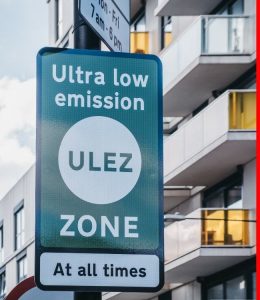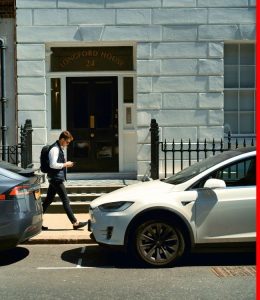Everything you need to know about Low Emission Zones in the UK
As the UK looks at ways to improve public health, low emission zones have become a big part of the health and environmental conversation. You might have already come across terms like LEZ, CAZ, or ULEZ, but what do they mean, where are they located, and what impact do they have on motorists, pedestrians and even cyclists?
What are Low Emission Zones and Clean Air Zones?
 Low Emission Zones (LEZs) and Clean Air Zones (CAZs) are designated areas where more polluting vehicles are charged a fee to drive. Vehicles that don’t meet certain emissions standards must pay a daily charge, encouraging drivers to switch to cleaner vehicles or alternative forms of transport.
Low Emission Zones (LEZs) and Clean Air Zones (CAZs) are designated areas where more polluting vehicles are charged a fee to drive. Vehicles that don’t meet certain emissions standards must pay a daily charge, encouraging drivers to switch to cleaner vehicles or alternative forms of transport.
These zones were introduced not just to help phase out petrol and diesel cars, but to improve public health. Poor air quality is linked to a host of respiratory and cardiovascular problems, so reducing pollution, including CO2 and harmful gasses like nitrogen oxide (NO2), helps take pressure off the NHS and keeps people healthier for longer.
The standards vehicles must meet to be exempt from these areas is usually based on Euro emissions ratings. For petrol cars, Euro 4 is the minimum (these became standard around 2005), while diesel vehicles must typically meet Euro 6 (introduced from 2015 onwards).
What are the different types of zones?
There are four categories of Clean Air Zones, each targeting different types of vehicles:
| Class | Vehicles Affected |
| A | Buses, coaches, taxis, private hire vehicles |
| B | Class A plus HGVs |
| C | Class B plus vans and minibuses |
| D | Class C plus private cars (and optionally motorcycles) |
The stricter the class, the more types of vehicles are affected with fines or driving restrictions.
Where are these zones located?
- London: The Ultra Low Emission Zone (ULEZ) now covers all 32 boroughs, operating 24/7. Non-compliant cars are charged £12.50 a day, while vans and lorries face a £100 fee.
- Bath: A Class C zone since March 2021, it affects commercial vehicles but not private cars. In 2024, a report by Bath & Northeast Somerset council revealed it had helped reduce NO2 levels by 32%.
- Bradford: In place since September 2022, this zone is also Class C and has reportedly saved the NHS around £30,000 a month by reducing pollution-related health issues.
- Birmingham: Its Class D zone covers the city centre and includes private cars. In 2022, NO2 levels had dropped by 17% compared to 2019.
- Oxford: The UK’s first Zero Emission Zone (ZEZ) charges all petrol and diesel vehicles in select city centre streets. Plans are in place to double the charges by 2025.
- Sheffield: A Class C zone introduced in 2023, charging older commercial vehicles between £10-£50 per day.
- Newcastle and Gateshead: Launched in 2023, this Class C zone applies to older taxis, vans, and HGVs.
- Portsmouth: A Class B zone, charging non-compliant taxis, buses, and HGVs (excludes private cars).
- Glasgow: Scotland’s first LEZ was introduced in 2023. Non-compliant vehicles are fined £60, with increasing penalties for repeat offences. It does not include local residents.
- Edinburgh: Launched in 2024, the city centre LEZ follows the same emission standards as Glasgow.
What impact have these zones had?
 London’s ULEZ provides the best insight into how effective these zones can be.
London’s ULEZ provides the best insight into how effective these zones can be.
Since expanding in 2023, London has seen:
- A 27% drop in NO2 concentrations across the city
- Up to 54% reductions in central areas
- 5 (fine particulate matter) emissions down 29% across London
- A 2% reduction in CO2 emissions since 2019
- A vehicle fleet that’s now 96.7% compliant with ULEZ standards.
- Nearly 100,000 fewer non-compliant vehicles on the road each day
- Health improvements, including an 80% drop in people exposed to illegal pollution levels.
Meanwhile, the Congestion Charge Zone (CCZ) has helped cut car traffic in inner London by 6%, stabilising road use and helping keep emissions in check.
What’s next for Low Emission Zones?
Expect more zones and coverage, and possibly tighter restrictions.
- London: There are ongoing reviews into expanding the ULEZ or tightening standards further. Although, plans for a Zero Emission Zone have been scrapped.
- Greater Manchester: Rather than introduce a charging CAZ, the region is focusing on investment in electric buses and taxi upgrades to hit its air quality goals by 2026.
- Other Cities: Additional LEZs are being considered, and it’s likely more urban areas will follow suit as part of the UK’s net-zero strategy. The ZEZ in Oxford is also undergoing a review for future expansion.
What this means for you
If you’re driving a non-compliant petrol or diesel car, you could face increasing costs when travelling into UK towns and cities. That’s one reason why more drivers and employers are exploring electric or hybrid cars through salary sacrifice schemes like Tusker’s.
Find out more
Links
- Bath report: Bath’s Clean Air Zone Annual Report Summary 2023
- Bradford report: Bradford clean air zone saves NHS over £30,000 a month in first year
- Birmingham report: Birmingham’s Clean Air Zone continues to help improve air quality in the city centre
- Oxford charges could double: Charges for Oxford’s zero emission zone (ZEZ)
- Sheffield CAZ: Sheffield Clean Air Zone – Key Information
- Newcastle & Gateshead CAZ: Newcastle and Gateshead Clean Air Zone – Key Information
- Portsmouth CAZ: Cleaner Air Portsmouth – Clean Air Zone – Key Information
- Glasgow £60 fine: Glasgow’s LEZ – Key Information
- Edinburgh CAZ: The City of Edinburgh Council – Low Emission Zone
- London ULEZ report: London-wide Ultra Low Emission Zone One Year Report
- Manchester scraps CAZ: Manchester City Council – Clean Air Zone Information
